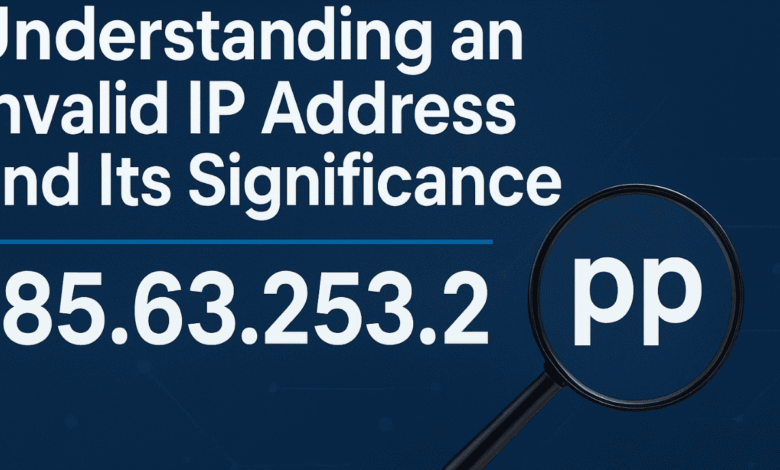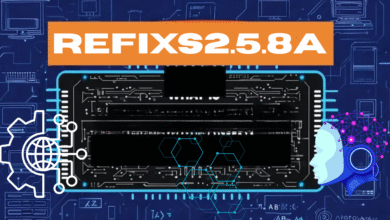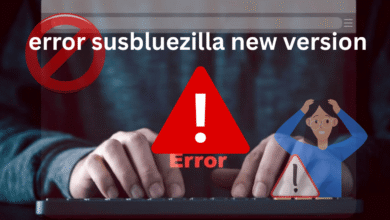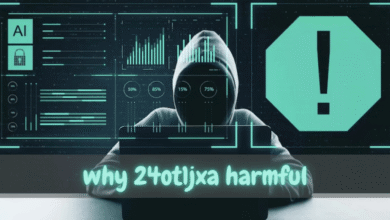185.63.253.2pp Understanding an Invalid IP Address and Its Significance

The term 185.63.253.2pp looks like a regular IP address at first glance, but it carries an unusual twist that makes it invalid. In networking, Internet Protocol (IP) addresses must follow strict formatting rules to function correctly. The addition of the letters “pp” at the end of this address makes it fall outside of valid IPv4 standards. This simple error creates confusion and provides a perfect example of how small deviations in technical information can lead to larger networking or connectivity issues.
What Makes 185.63.253.2pp Invalid
An IPv4 address is made up of four sets of numbers separated by dots, with each number ranging from 0 to 255. For example, an address like 192.168.1.1 fits within these rules. The address 185.63.253.2pp fails to meet this standard because of the non-numeric characters attached at the end. In practice, this makes it impossible for any computer system to resolve or connect to such an address. It highlights the importance of precision in network configuration.
Common Causes Behind Malformed IP Addresses
The appearance of something like 185.63.253.2pp can happen for several reasons, and understanding these causes can help prevent similar mistakes.
- Typographical mistakes during manual entry of an IP.
- Use of placeholder text to indicate an incomplete or example address.
- Data corruption in a logging or monitoring system.
- Bugs in scripts or automated processes that generate malformed output.
- Attempts to obfuscate real IP addresses without fully hiding sensitive details.
In all these cases, the root problem is the same: the entry is invalid and does not conform to the structure that networking protocols require.
Why Invalid Addresses Like 185.63.253.2pp Matter
An incorrect entry such as 185.63.253.2pp might look harmless, but it can cause major challenges in real scenarios. Systems depending on proper communication can fail to connect, logging systems can misinterpret traffic, and troubleshooting becomes more difficult when invalid data is present. For businesses, even a small formatting mistake in network documentation can result in downtime, inefficiency, and wasted resources while administrators track down the source of errors.
Technical Breakdown of IPv4 Format
To fully appreciate why 185.63.253.2pp is not valid, it helps to revisit how IPv4 works. Each segment of the address is known as an octet, representing values between 0 and 255. With four octets separated by dots, the system uniquely identifies devices across networks. Adding letters or any character outside of the numeric range, such as “pp”, creates a format that no network device can interpret. This is why validation tools reject the entry instantly.
Lessons Learned from 185.63.253.2pp
Looking at 185.63.253.2pp provides valuable lessons for both beginners and experienced network administrators:
- Always validate addresses before implementing them into configuration files.
- Avoid using placeholders that look too much like real IPs to prevent confusion.
- Use monitoring tools that can detect and highlight invalid entries quickly.
- Train teams on the importance of accuracy in technical documentation.
These points stress that precision is not just a technical requirement but a safeguard for smooth operations.
Security and Logging Implications
In security contexts, invalid addresses like 185.63.253.2pp can create noise in logs. Cybersecurity teams often monitor large datasets of IP traffic, and malformed addresses can mislead or distract from real threats. In some cases, attackers may even use invalid-looking addresses as a tactic to confuse systems or analysts. This underlines the need for automated validation filters that quickly flag such anomalies.
Real-World Scenarios Where It Can Happen
The presence of an entry such as 185.63.253.2pp could appear in different situations:
- A user mistypes while setting up a firewall rule.
- A monitoring system logs corrupted data from a malfunctioning source.
- A developer uses it as a placeholder during code testing.
- An internal document mistakenly lists it, leading others to copy the same error.
Each of these examples shows how small mistakes propagate, causing larger issues down the line if not noticed in time.
Preventing Errors Like 185.63.253.2pp
Avoiding invalid entries requires a mix of awareness, training, and technical safeguards. Network administrators can use address validation tools to check IPs before deploying them. Automated systems can be configured to reject malformed entries. Teams should also be educated on proper documentation practices. These preventive measures help keep operations clean and efficient.
Broader Importance of Accurate Data Entry
Beyond the world of IP addressing, 185.63.253.2pp symbolizes a bigger problem in digital work environments: the danger of small inaccuracies. Whether in networking, coding, or database management, a single misplaced character can result in wasted time and significant frustration. This emphasizes the universal value of accuracy across all digital disciplines.
Key Takeaways from 185.63.253.2pp
- The address is not valid because it breaks IPv4 format rules.
- Mistakes like this often come from typos, placeholders, or automation errors.
- Such errors can cause real disruptions in networking and logging.
- Security teams must remain vigilant against malformed entries.
- Validation and preventive measures are the best defense against these mistakes.
Conclusion
The example of 185.63.253.2pp serves as a reminder that even the smallest formatting errors can create big complications in networking and data management. By understanding why it is invalid, where such mistakes come from, and how to prevent them, both individuals and organizations can maintain smoother operations. It reinforces the lesson that accuracy in technical details is not optional but essential. In the end, 185.63.253.2pp is more than just a broken address; it is a teaching point for anyone working with digital systems, showing the importance of vigilance, validation, and precision.
Frequently Asked Questions
1. What is 185.63.253.2pp?
185.63.253.2pp is an invalid IP address that appears to follow the IPv4 format but contains extra characters at the end, making it unusable for network communication.
2. Why is 185.63.253.2pp considered invalid?
IPv4 addresses can only contain four sets of numbers between 0 and 255, separated by dots. The addition of “pp” at the end violates this rule, which makes the address invalid.
3. Can 185.63.253.2pp be used for internet connections?
No, since it does not meet the proper IPv4 structure, it cannot be assigned to any device or used for network routing.
4. How can such an address appear in logs or documents?
It may result from human typing errors, placeholder usage, data corruption, automated script bugs, or intentional obfuscation.
5. What problems can occur if 185.63.253.2pp is used in configurations?
Using an invalid IP can cause failed connections, system errors, and delays in troubleshooting. It may also lead to misinterpretation of network data.



